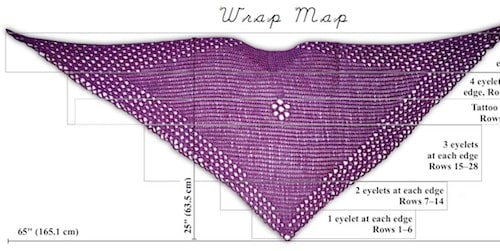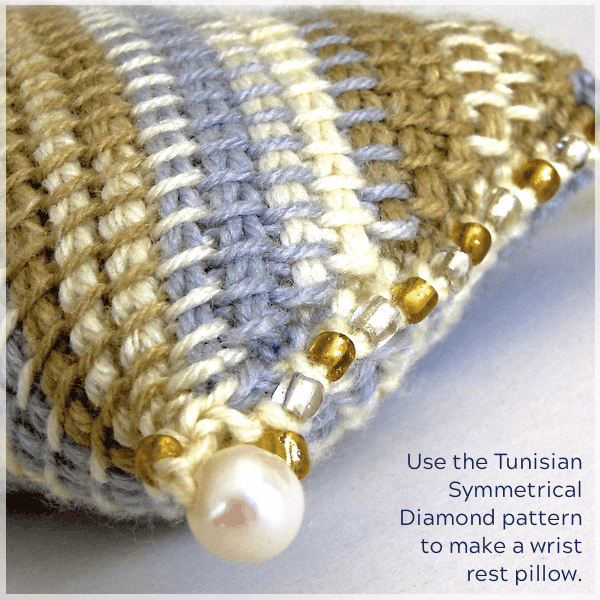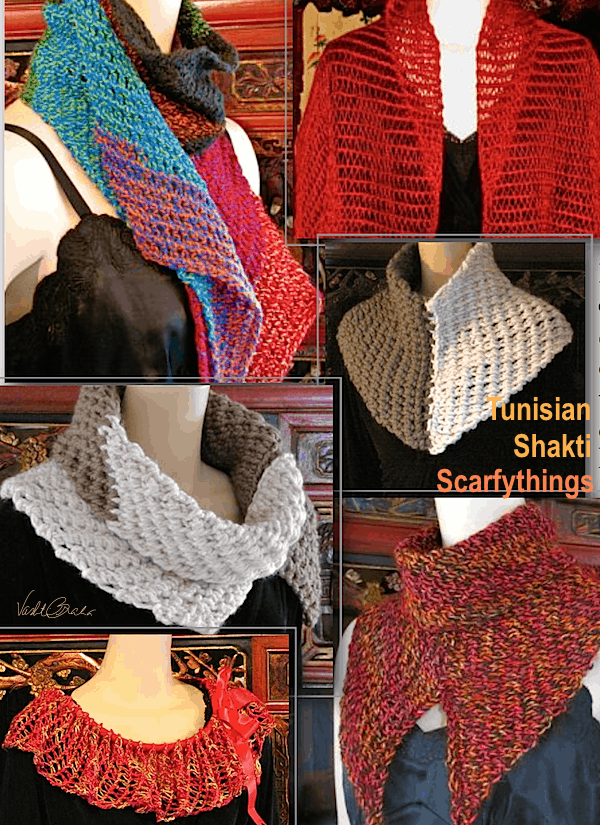This simple scarf & wrap pattern is really all about one powerful Tunisian crochet stitch. Quickly crochet easy scarves, wraps and shawls with this exciting lacy Tunisian crochet stitch. Learn to crochet it on the bias with any yarns and crochet hook sizes, then try seaming your scarf four different ways for new fashion looks.
As a “superpattern,” pattern includes a menu of six projects for you to choose from. Use it for your own freeform crochet: pair your own yarn and hook size, choose how many chains you start with and how many rows you end with, and try a new way of seaming it.
Crocheting this stitch on the bias feels so natural that it’s my first choice for crocheters new to crocheting on the bias. Oddly, this stitch has no standard name or description, and doesn’t seem to be one of the basic stitches one learns after the Tunisian Simple Stitch, even though it’s easy to do! I’ve seen it called several different names. I prefer Extended Knit Stitch and abbreviated it Tkes in this pattern.
The rows bias effortlessly for a dynamic stretch and flowing drape. The stitch is equally lovely in a tighter gauge for a solid warm scarf, or crocheted very loosely for a lacy layer, so this one pattern spans every season. I like wearing it as a narrower scarf, and also as a wider wrap.
The possibilities get even more exciting when I’ve tried seaming it four different ways! A mobius with a corner is one of my favorite results. The Tkes so versatile is that it looks great on both sides, so it’s a natural choice for a scarf or wrap with a mobius twist.
Skill Level
Easy. You should already be familiar with beginner Tunisian crochet patterns; you might like this handy checklist. This pattern is a good introduction to these other DesigningVashti patterns: Tunisian Islander Wrap (same stitch with a fancier edge), Neck Lattice (published in Simply Crochet by Interweave Press ©2011), Four Peaks (offset Tunisian Simple Stitch with eyelet edge), and most recently, Eilanner.
UK and Australian equivalents to American measurements, yarn weights, and stitch terms are provided in brackets. After using this pattern you will know (if you didn’t already):
- How to crochet the Tunisian Extended Knit Stitch
- How biasing works with Tunisian crochet stitches
- How to crochet easy Tunisian lace by pairing a crochet hook size and yarn
- How to seam a crochet scarf into four or more fashion wraps
Finished Dimensions
With materials used, tips & wearing notes for six projects. I have so many images for this pattern that I invite you to see more in this online photo set.
For several projects shown I used a size L/US11/8mm Tunisian crochet hook used, at least 8″ {20.5 cm} long. For some I used a size N/US15/10mm, and a size K/US10.5/6.5mm hook would also work great with some yarns.
Colorblock-Shakti: I love wearing this one unseamed as a simple scarf, because it shows off the diagonal color blocks the best. I also like how the wool fibers felt together a bit over time for a warm soft scarf. If I had 100g-150g of this yarn instead of 75g, I’d make the scarf slightly wider and longer.
- Measured hung and unseamed, 64″ long X 6.5″ wide {163 cm X 16.5 cm}.
- Yarn used: An anonymous self-striping mill-end yarn that is most likely merino wool; its weight category appears to be #3 (DK, light worsted). Yardage unknown; scarf weighs 2.65oz {75g}. For a fun scrap yarn project that approximates this look, crochet two strands held together of 8 contrasting #1 Super Fine Weight yarns (Fingering or light sock yarn, 3-ply baby yarn).
Swizzle-Shakti: As a 1-skein project, I like this one several ways, such as partially seamed with a half-twist mobius-style cowl. However, I love the luxurious feeling of it and its dramatic tiger pelt look, so I’d also like it longer and wider to wear as a wrap.
- Measured hung and unseamed, 46″ X 7″ {117 cm X 18 cm}.
- Yarn used: The Alpaca Yarn Company Swizzle (100% superfine alpaca; 215yd/197 m per 3.5oz/100g skein), 1 skein of color 07 Tiger Lily.
Skinny-Shakti: I like this one as a ruffled collar tied with a ribbon drawstring, instead of wearing it as a long skinny scarf, because it’s the only way that the stitch texture shows. I’d like it even more if I had a soft silk tie to use instead of the ribbon.
- Measured hung and unseamed, collapses to 88″ X 2″ {approx. 220 cm X 5 cm}
- Yarn used: Tilli Tomas Rock Star (100% silk with beads; 150yd/137m per 3.5oz/100g skein), 1 skein of color Ginger.
Red Mohair Veil: I love draping this fabric around me, and have plenty of yarn left to make it bigger. It’s weightless but warm, delicate and strong, and soft with an elegant sheen. It’s already a good bare-minimum width for me as a wrap, fine for throwing around my shoulders easily without catching on anything while I’m sitting.
- Measured hung and unseamed, 53″ X 12.5″ {135 cm X 32 cm}.
- Yarn used: Wagtail Yarns 4-Ply (100% Fine Kid Mohair; 410yd/375m per 3.5oz/100g skein), 1 skein of color 350 300, Winter Red.
Mobi-Dickie: I most like this one seamed with a half-twist, mobius-style. This is a stiffer but still soft fabric for more structured looks. Hanging it doesn’t change its dimensions much, but it does stretch nicely when worn.
- Measured flat, 33″ X 9.5″ {84 cm X 24 cm}.
- Yarn used: Lion Brand Wool-Ease Thick & Quick (80% acrylic, 20% wool; 108yd/99m per 6oz/170g skein), one skein of Wheat and half of a skein of Taupe for 2-color version.
Suave Shoulders: This capelet-type cowl variation of Mobi-Dickie is seamed as a simple tube, and stretches wider at the shoulder than at the neck.
- Measured flat, 33″ X 12″ {84 cm X 30.5 cm}.
- Yarn used: Lion Brand Wool-Ease Thick & Quick (80% acrylic, 20% wool; 108yd/99m per 6oz/170g skein), one skein of Wheat and one skein of Taupe for 2-color version.




